Auspicious days celebrated at Nalanda Monastery
The four main events of Buddhism related to Buddha Shakyamuni
Buddhism weaves its spiritual rhythm around a series of sacred observances that illuminate the traditional buddhist lunar calendar. All buddhist traditions celebrate four particular days commemorating each a particular event and powerful deed of Shakyamuni Buddha for all beings’ sake – Chötrül Düchen, Saka Dawa Düchen, Chokhor Düchen, and Lhabab Düchen.
Chötrül Düchen is celebrated on the full moon of the 15th day of the 1st lunar month of the year.
This day is the culmination of the preceding 15-day period known as the Miracle Month during which Buddha Shakyamuni demonstrated miraculous powers in order to subdue six tirthikas – non-buddhist teachers – who lacked faith in him, and to inspire his followers.
Saka Dawa Düchen is celebrated on the full moon of the 15th day of the 4th lunar month.
On this day we celebrate Buddha Shakyamuni’s birth, enlightenment, and parinirvana.
Chökhor Düchen is celebrated on the full moon of the 15th day of the 8th lunar month.
This day marks the first turning of the Wheel of Dharma by Buddha Shakyamuni.
Lhabab Düchen is celebrated on the 22nd day of the 9th lunar month.
On this day we celebrate Buddha Shakyamuni’s return to Earth from the realm of the Thirty Three Devas after having taught Dharma to his mother Mayadevi, and to the other devas.
It is said that on these special days, the effects of karmic deeds are multiplied by 300 million times. One of Lama Zopa Rinpoche’s advice for increasing meritorious karma is to take or renew the eight Mahayana vows. Thanks to Kopan Monastery, students can receive the lineage of these vows directly from Lama Zopa Rinpoche : YouTube link.
Furthermore, Lama Zopa advises us to recite the Sutra Remembering the Three Jewels : FPMT Box link.
The two main events of the Gelug School related to Lama Tsonghkapa (1357 – 1419)
Following our Gelugpa lineage, the life and deeds of Lama Tsongkhapa are also of great import at Nalanda Monastery which we celebrate by observing Ganden Ngamchoe and the Gelug Monlam Chenmo Festival.
Ganden Ngamchoe also known as Lama Tsongkhapa’s Day is celebrated on the 25th day of the 10th lunar month.
This day marks the parinirvana of Lama Tsongkhapa.
Gelug Monlam Chenmo Festival takes place during the 10 days preceding Chötrül Düchen.
The Gelug Monlam Chenmo was first established by Lama Tsongkhapa in 1409. It is also during this period that Gelugpa monks pass their examinations to obtain the academic title of Geshe Lharampa.
Fulfilling one of the holy wishes of Lama Zopa Rinpoche, Nalanda Monastery established this ancient tradition in the West for the first time in February 2024.
You can watch our documentary on the Gelug Monlam Chenmo in the West here: Youtube link.
Chötrul Düchen - Festival of Buddha’s Display of Miracles
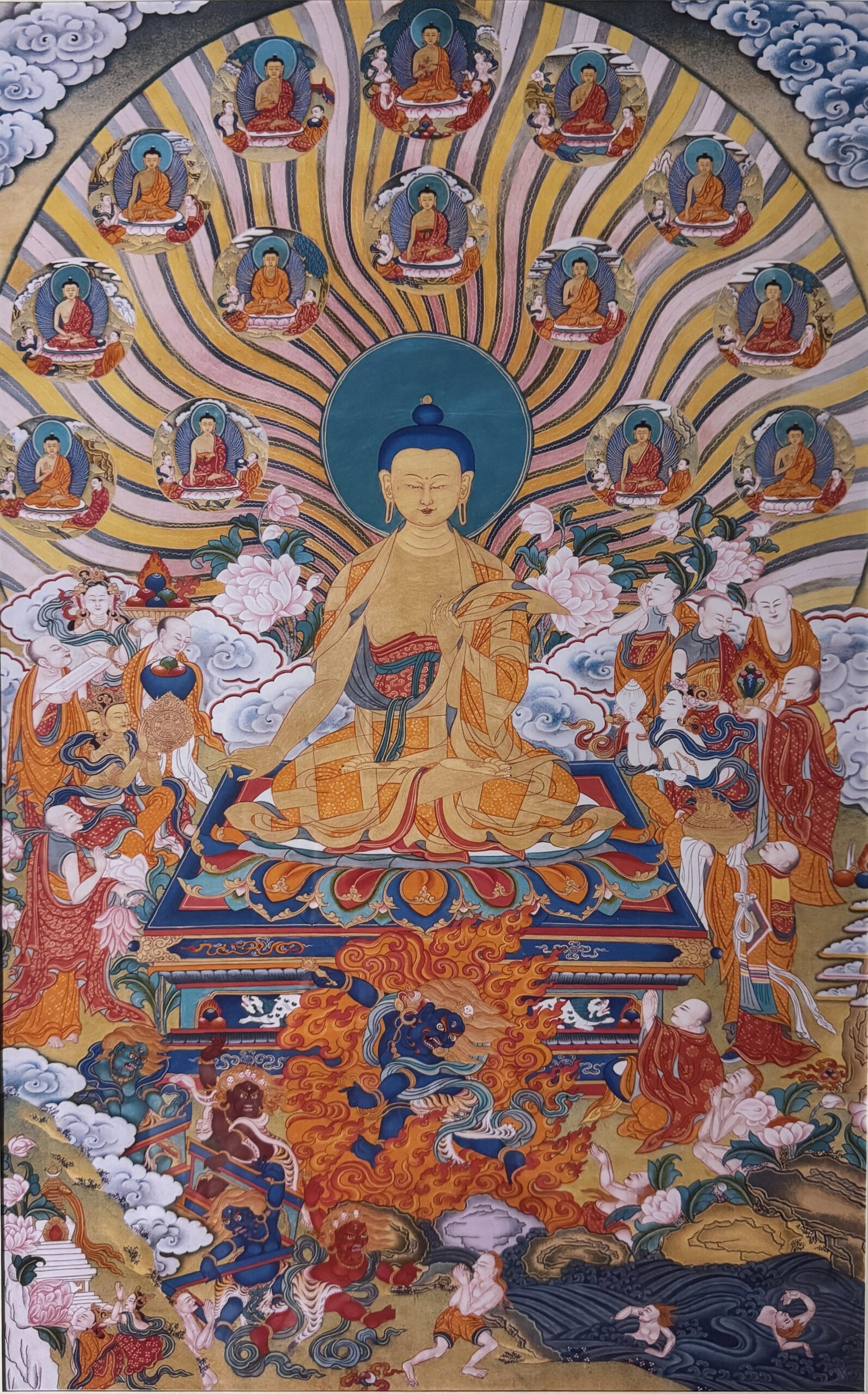 Chötrul Düchen (Day of Miracles) is celebrated on the 1st full moon day of the year, the 15th day of the New Tibetan Year.
Chötrul Düchen (Day of Miracles) is celebrated on the 1st full moon day of the year, the 15th day of the New Tibetan Year.
The Festival of Chötrul Düchen commemorates the series of miracles the Buddha performed in Sravasti, India, when he was confronted by six non-buddhist philosophers. To reaffirm the power of the Dharma and to strengthen the devotion of his followers, the Buddha manifested fifteen extraordinary feats over fifteen days.
The celebration itself begins with Losar, the Tibetan New Year, and extends through the ensuing fifteen days, culminating on the full‑moon of the first lunar month.
Saka Dawa Düchen - Buddha's birth, enlightenment and parinirvana
The fourth month of the Tibetan lunar calendar is known as Saka Dawa, revered as the most auspicious month of the year. It is called the “Month of Merits,” and practitioners devote extra care to performing virtuous deeds while avoiding harmful actions. It is believed that the karmic impact of every act is amplified a thousandfold throughout the month.
On the fifteenth day of Saka Dawa falls the great festival of Saka Dawa Düchen. This day commemorates the three pivotal events in the life of Shakyamuni Buddha : his birth, his full enlightenment, and his final passing into non‑abiding nirvana – parinirvana.
In the Lumbini garden he entered the world as the supreme emanation body of boundless compassion.
At Bodhgaya, he attained complete and perfect enlightenment.
Finally, at Kushinagar, he entered the final nirvana.
You can follow Lama Zopa Rinpoche’s advice for Saka Dawa on the FPMT’s website: Advice for Saka Dawa Duchen – FPMT and watch his video : YouTube link.
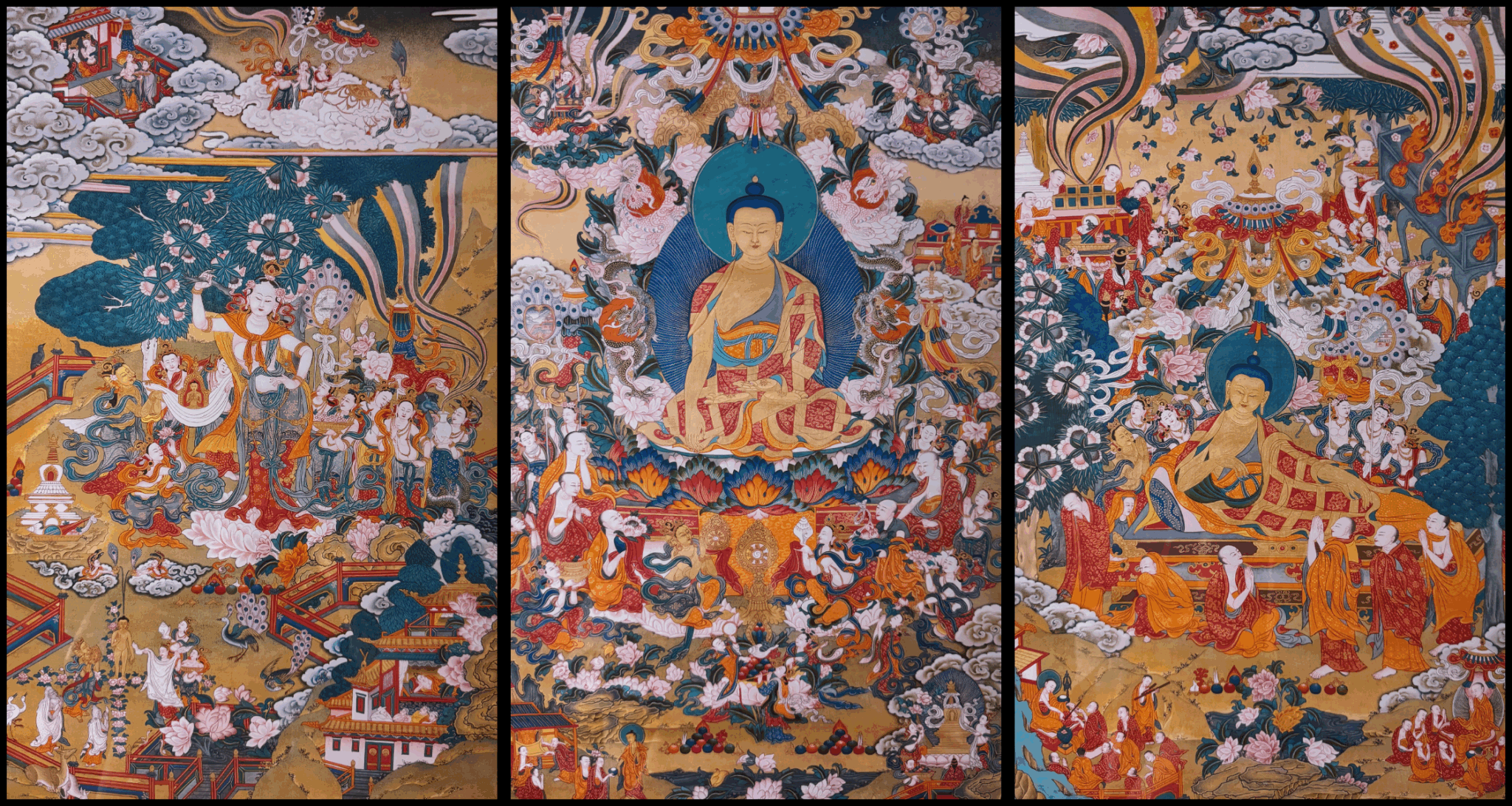
Chökhor Düchen - fist turn of the wheel of Dharma
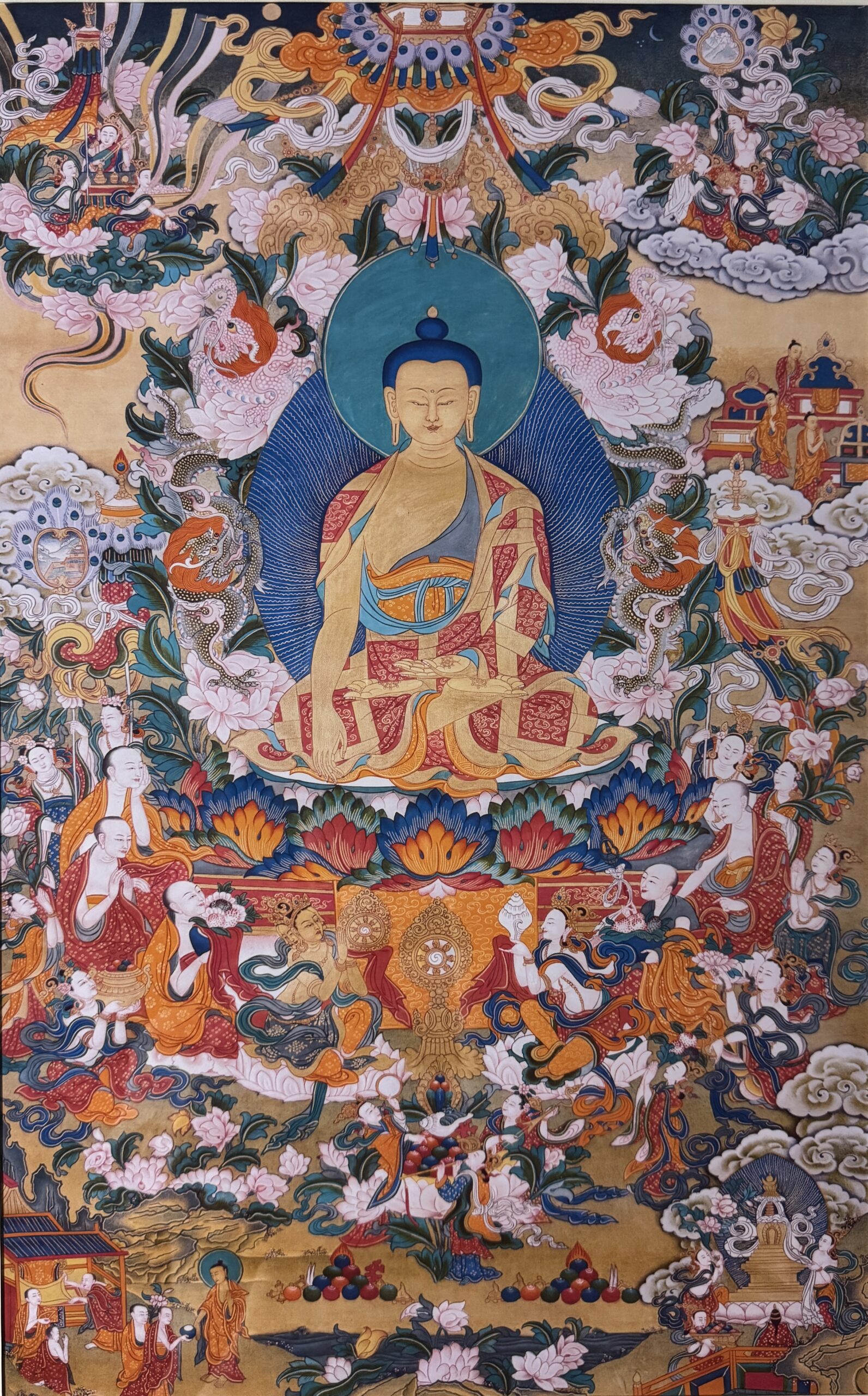 Chökhor Düchen is celebrated each year on the 15th day of the 8th lunar month and marks the first teaching that Shakyamuni Buddha gave at Deer Park in Varanasi, after having reached enlightenment beneath the Bodhi tree at Bodhgaya.
Chökhor Düchen is celebrated each year on the 15th day of the 8th lunar month and marks the first teaching that Shakyamuni Buddha gave at Deer Park in Varanasi, after having reached enlightenment beneath the Bodhi tree at Bodhgaya.
Legend holds that after his enlightenment the Buddha remained silent for seven weeks. Then the celestial beings Indra and Brahma presented a Dharmachakra and a conch shell, urging him to teach. Accepting their invitation, the Buddha turned the wheel of Dharma for the first time at Sarnath, unveiling the Four Noble Truths to the assembled audience.
In that teaching the Buddha presented the Four Noble Truths:
- The truth of suffering (dukha)
- The truth of the origin of suffering
- The truth of cessation of suffering
- The path to liberation from suffering – the Eightfold Path
Lhabab Düchen - Buddha's return to Earth from the Realm of the Thirty-Three
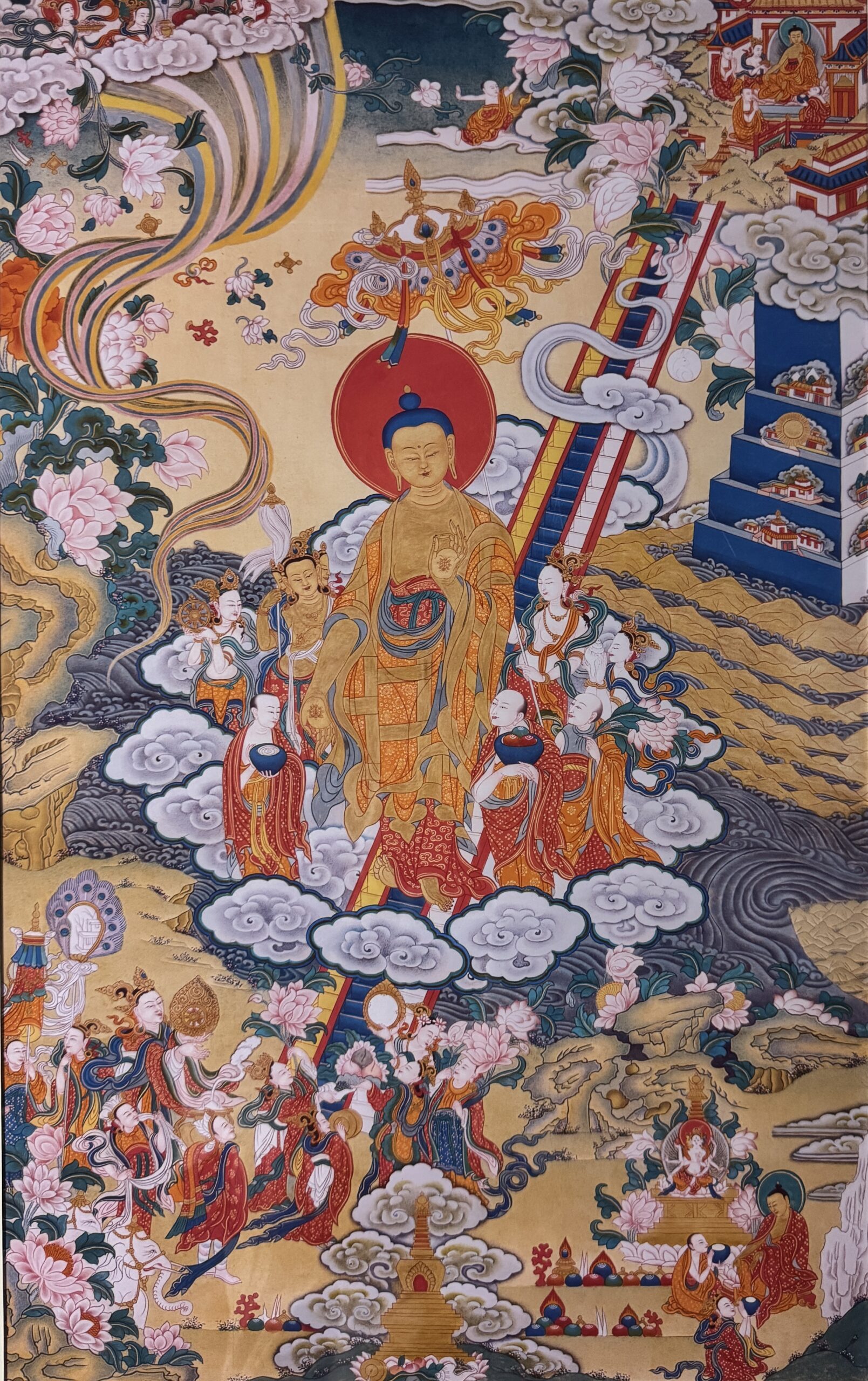
Lhabab Düchen is observed on the 22nd day of the 9th lunar month. The festival commemorates the voluntary return of Shakyamuni Buddha to earth, after having taught the beings of the Trayastrimsa heaven (Realm of the Thirty-Three Devas), to continue guiding sentient beings.
The tradition holds that after the great debate at Sravasti (celebrated during Chötrul Düchen), to avoid being treated as a god, the Buddha vanished and reappeared in the Heaven of the Thirty-Three, on the very peak of Mount Sumeru. The Budda, in gratitude, had vowed to repay his mother Mayadevi for all that she had done for him, and, as she was then residing in this heaven, he taught her and others so that they too might be free from samsara. After three months, Maudgalyayana, one of the Buddha’s main disciples, begged him to return to earth. The Buddha agreed and at the appointed time descended on a triple staircase made of lapis lazuli, gold and crystal.
This day is regarded as highly auspicious and the merit generated by virtuous deeds is believed to be multiplied ten million times, making it an especially potent occasion for practicing generosity, reciting prayers, and dedicating one’s efforts to the welfare of all sentient beings.
Ganden Ngamchoe - Lama Tsongkhapa's parinirvana
 We celebrate Lama Tsongkhapa’s parinirvana on the 25th day of the 10th month of the Tibetan lunar calendar.
We celebrate Lama Tsongkhapa’s parinirvana on the 25th day of the 10th month of the Tibetan lunar calendar.
Lama Tsongkhapa also known as Je Tsongkhapa (1357 – 1419) of his ordained name Losang Drakpa was a tibetan monk and teacher, whose activities led to the foundation of the Gelug school.
In 1409 he started renovation work on the Jokhang temple in Lhasa and in the same year laid the foundation of the Ganden Monastery. His students Tashi Palden and Shakya Yeshe respectively founded Drepung Monastery in 1416 and Sera Monastery in 1419. These three monasteries would become great seats of the Gelug school and largest monasteries in Tibet.
Among his many achievements we can highlight his most famous work – Lamrim Chenmo, the Great Exposition of the Stages of the Path – a commentary on Atisha’s treatise “A Lamp for the Path to Enlightenment”. Tsongkhapa’s Lamrim Chenmo outlines the Mahayana path to enlightenment and presents the Madhyamaka view on emptiness. Tsongkhapa ends the study of the path with the Great Exposition of Secret Mantra.
How to accumulate merits on that special occasion?
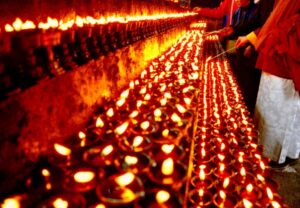 Lama Zopa Rinpoche gives us precious advice for this most auspicious day:
Lama Zopa Rinpoche gives us precious advice for this most auspicious day:
- Puja of 1000 offerings to Lama Tsongkhapa
- The practice of Lama Chopa with extensive offerings
- Extensive light offerings
“We still have access to Jé Rinpoché’s teachings. Their lineage of transmission survives. What we have to do is to learn how to put them into practice. To help me do this I read the special insight and awakening mind sections of the ‘Great Treatise on the Stages of the Path’. As we acquaint our minds with what is to be practised, familiarizing ourselves with it over and again, it will have an effect. Transformation will take place.”
His Holiness the 14th Dalai Lama
Gelug Monlam Chenmo - Great Prayers Festival
Lama Tsongkhapa initiated the Gelug Monlam Chenmo – Great Prayers Festival – in Lhassa at the Jokhang Temple for the first time 1409, to commemorate the “Month of Miracles”. The Gelug Monlam Chenmo starts after the Tibetan New Year – Losar and ends on the following full moon – Chötrul Düchen. It is also during this festival that final examinations and debates for the title of Geshe Lharampa take place.
Following Lama Zopa Rinpoche’s holy wish, Nalanda Monastery initiated the Gelug Monlam Chenmo in the West in 2024.
If you want to learn more about the Gelug Monlam Chenmo, you can watch our movie below.
